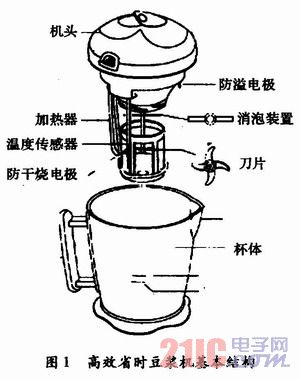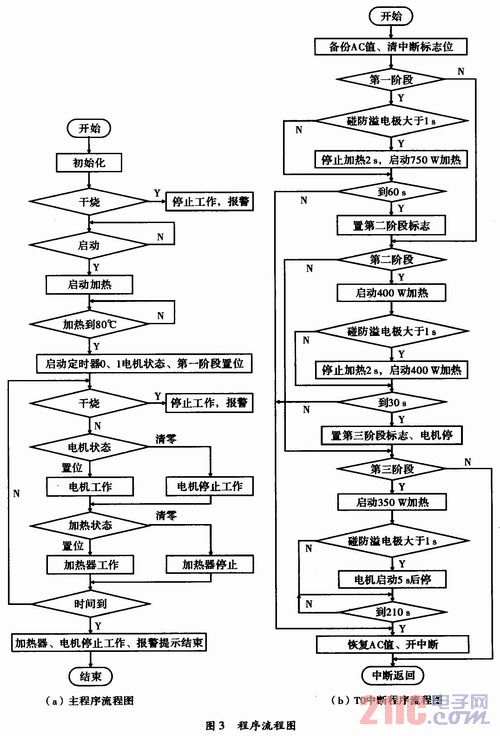Aiming at the problem of long time of soymilk mechanism slurry, a design scheme of high-efficiency and time-saving soya-bean milk machine based on SH69P42 single-chip microcomputer was proposed. Without changing the basic structure and function of the original soybean milk machine, a simple elimination was installed on the motor spindle. The bubble device is treated in parallel by heating and refining. The simultaneous control strategy of heating and defoaming can shorten the pulping time to 50% of the existing soymilk machine and improve the use efficiency. Practice has proved the feasibility of the program and has great market potential.
Keywords soybean milk machine; defoaming device; SH69P42 single chip microcomputer
Soymilk is an economically healthy food that is becoming more and more popular. At present, the soymilk mechanism slurry on the market takes about 20 minutes, which brings time inconvenience to families who work in the morning. In this paper, an efficient and time-saving soymilk machine based on SH69P42 single-chip microcomputer is designed for the problem of long pulping time. On the basis of maintaining the structure and function of the existing soya-bean milk machine, the soya-bean milk machine is equipped with a simple defoaming device on the spindle of the refining motor, and the parallel control of heating and refining, heating and defoaming simultaneously control strategies are avoided. At present, the soymilk machine is heated and refined separately, and the waiting time is delayed by the heating of the static boiling stage.
1 The basic structure of the soymilk machine Figure 1 shows the basic structure of the high-efficiency and time-saving soya-bean milk machine. This structure is installed with a defoaming device above the main shaft of the rotating machine without changing the structure of the original soya-bean milk machine. At this time, the motor has the functions of refining and defoaming. The refining stage is mainly based on refining function, and the defoaming function is supplemented. In the stage of boiling, the defoaming function is mainly used, and the refining function is supplemented.
This article refers to the address: http://

2 control system circuit and working principle control system circuit shown in Figure 2, the circuit by Zhongying company SH69P42 microcontroller, temperature detection circuit, overflow detection circuit, dry burn detection circuit, motor control drive circuit, heater control drive circuit, Buzzer alarm drive circuit and power circuit.

Zhongying's SH69P42 is an advanced CMOS 4-bit microcontroller that integrates the SH6610D CPU core, RAM, ROM, timer, I/O port, 2-channel 10-bit PWM, watchdog timer, and 4-channel 8 Bit ADC, low voltage reset, widely used in household appliances and electric vehicle controllers.
The 220 V AC power supply is stepped down by the transformer and bridge rectified to obtain a voltage of +12 V, which supplies power to the relays K1 to K2 and the buzzer. The three-terminal regulator 78L05 outputs +5 V to supply power to the microcontroller. The SH69P42 uses an internal RC oscillator with a frequency of 4 MHz. The PC1 pin of the SH69P42 outputs an alarm signal, which is amplified by the Q3 transistor to drive the buzzer alarm. PC2 outputs the motor drive signal, which is amplified by the transistor Q1, drives the relay K1 to pull in, controls the motor to run, and can complete the beating and defoaming work. PC3 outputs the heating signal, which is amplified by the transistor Q2, drives the relay K2 to pull in, and controls the heating tube to heat. PB3 is the water shortage detection input terminal, PB2 is the overflow detection input terminal, and PA1 is the temperature detection input terminal. The water shortage detection circuit is composed of R8, C9 and the temperature measuring electrode housing, and the outer casing of the heating tube is grounded. When the normal working, the PB3 pin inputs a low level; if the water level is lower than the temperature measuring electrode, the PB3 pin inputs a high level. The heating and the motor are automatically powered off to achieve water shortage protection, and at the same time, the buzzer emits a rapid alarm sound. In the same way, it can be detected whether the soy milk overflows. The anti-overflow electrode is connected to the PB2 pin. Before the soy milk boils, the anti-overflow electrode is away from the water surface, and the PB2 pin is at a high level. When the foam rises and contacts the anti-overflow electrode, the PB2 pin is at a low level.
3 Soymilk Workflow and Control System Software Design Put the soaked soybeans or dried beans and water into the cup as required, plug in the power plug, press the start button and you will hear the buzzer sound, the microcontroller will start working, PC3 foot Output high level, K2 pulls the heating tube to start heating; PA1 pin is connected with negative temperature coefficient thermistor (NTC), the thermistor is installed in the temperature measuring electrode, when the water temperature rises to about 80 °C, PA1 foot It is low level, at this time, the PC2 pin is controlled to be high level, and the K2 pull-in motor starts to work. The blade mounted on the rotating shaft rotates at a high speed to break the soot and produce soy milk. When it overflows for the first time, it enters the first stage heating and starts 750 W heating, and the heating time is 60 s. During this period, when it is judged that there is overflow, the heating stops for 2 s and then continues to heat. After entering the second stage, 400 W heating is started, and the heating time is 30 s. During this period, when it is judged that there is overflow, the heating is stopped for 2 s and then heating is continued. At the end of the second phase, the motor stops rotating. After entering the third stage, start 350 W heating, the heating time is 210 s. During this period, when it is judged that there is overflow, the heating does not stop, but the motor stops after 5 s, and the motor mainly plays the role of defoaming until the end. The buzzer sounds evenly, indicating that the soy milk is cooked and the system is stopped. Figure 3 is a flow chart of the control system. It can be seen that the entire pulping process is about 10 minutes, which is about 1 times higher than the efficiency of the soybean milk machine on the market.

4 Conclusion The MCU control system has the advantages of strong anti-interference ability, strong and weak electrical isolation, software with watchdog, safe and reliable, especially high power heating to shorten the warm-up time, and at the same time in the low-power cooking stage. Defoaming control keeps the heating non-stop, ensuring that the soy milk is fully cooked and has a rich flavor, avoiding the overflow of soymilk and shortening the overall pulping time. Based on the design scheme of SH69P42 single-chip high-efficiency and time-saving soya-bean milk machine, a simple defoaming device is installed on the motor main shaft without changing the basic structure and function of the original soya-bean milk machine, and heating and refining are processed in parallel, heating and defoaming are simultaneously performed. Control strategy. Practice has proved that this program can shorten the pulping time to 50% of the existing soya-bean milk machine and improve the efficiency.
Copper-Clad Aluminum Core Wire,Copper Clad Aluminum Metal Wire,Copper Clad Aluminum Pure Copper Wire ,Copper Clad Aluminum Bimetallic Wire
changzhou yuzisenhan electronic co.,ltd , https://www.ccs-yzsh.com